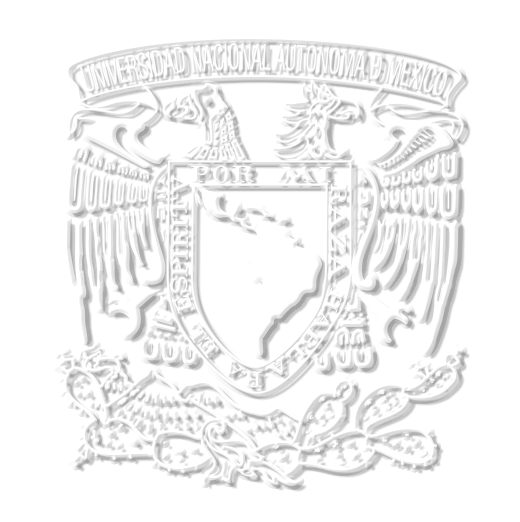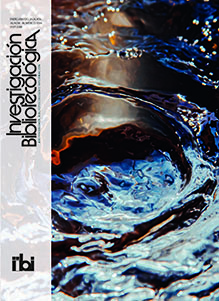Resumen
El objetivo de este trabajo tiene como finalidad identificar el crecimiento, las tácticas de control, la colaboración entre autores y las tendencias emergentes de la investigación científica relacionadas con estrategias de control de Dactylopius opuntiae (Cockerell) (Hemiptera: Dactylopiidae) por medio de indicadores bibliométricos. Con el fin de recuperar los artículos académicos relevantes sobre el tema, se consultaron seis bases de datos referenciales. Para recopilar la información bibliográfica, se empleó «Dactylopius opuntiae» en los campos de búsqueda: título, resumen y palabras clave. Se rescataron 1 212 registros, los cuales fueron enviados al software Zotero y, posteriormente, se revisaron para descartar repeticiones ajenas al tema, con lo que resultaron solo 99 desde el año 1848 al 2022. Estos registros sirvieron para obtener cuatro indicadores bibliométricos utilizando Excel y VOSviewer.
La dinámica de la producción científica fue más evidente durante los últimos siete años. El control biológico, a través de depredadores y entomopatógenos, fue el tema de investigación emergente más estudiado. De 1848 al 2000, sólo se encontraron 12 documentos de producción científica sobre tácticas de control de Dactylopius opuntiae (cochinilla silvestre); la producción se incrementó en una proporción mayor de 2016 a 2022. Las tácticas de control más destacadas estuvieron enfocadas al control biológico y al control químico no convencional utilizando diversos productos como: aceites, extractos de plantas, jabones y detergentes. Finalmente, el tema de investigación mayormente mencionado fue el «control biológico». En conclusión, se puede decir que los tópicos más investigados radicaron en los agentes de control biológico (depredadores y entomopatógenos) y la resistencia de las plantas, lo cual destacó como la táctica que podría ser más sostenible.
Citas
Akroud, Hayat, Mohamed Sbaghi, Rachid Bouharroud, Tayeb Koussa, Mohamed Boujghagh, and Mustapha El Bouhssini. 2021. Antibioisis and Antixenosis Resistance to Dactylopius opuntiae (Hemiptera: Dactylopiidae) in Moroccan Cactus Germplasm. Phytoparasitica 49(4): 623-31. http://doi:10.1007/s12600-021-00897-w
Bader, Ahmad Katbeh and Asem H. Abu-Alloush. 2019. First Record of the Cochineal Scale Insect, Dactylopius opuntiae (Cockerell) (Hemiptera: Dactylopiidae), in Jordan. Jordan Journal of Biological Sciences. Volume 12, Number 2, June 2019. ISSN 1995-6673: 155-159. https://jjbs.hu.edu.jo/files/vol12/n2/Paper%20number%205.pdf
Barreto-García, Oscar Arturo, Esteban Rodríguez-Leyva, José Refugio Lomelí-Flores, Juan Manuel Vanegas-Rico, Ana Lilia Vigueras, and Liberato Portillo. 2020. Laetilia Coccidivora Feeding on Two Cochineal Insect Species, Does the Prey Affect the Fitness of the Predator? BioControl 65(6): 727-36. http://doi:10.1007/s10526-020-10047-6
Bouharroud, Rachid, Abderrahim Amarraque, and Redouan Qessaoui. 2016. First Report of the Opuntia Cochineal Scale Dactylopius opuntiae (Hemiptera: Dactylopiidae) in Morocco. EPPO Bulletin 46(2): 308-10. http://doi:10.1111/epp.12298
Bouharroud, Rachid, Mohamed Sbaghi, Mohamed Boujghagh, and Mustapha El Bouhssini. 2018. Biological Control of the Prickly Pear Cochineal Dactylopius Opuntiae Cockerell (Hemiptera: Dactylopiidae). EPPO Bulletin 48(2): 300-6. http://doi:10.1111/epp.12471
Bufaur, Mazen, and Rami Bohamdan. 2020. First Report of the Opuntia Cochineal Scale Dactylopius opuntiae (Cockerell, 1896) in Syria. Arab Journal of Plant Protection 38(1): 59-63. http://doi:10.22268/AJPP-38.1.059063
Castellano Vera, Jessica, María Dolores Marrero Alemán, Zaida Ortega, Francisco Ramón Romero Artiles, Antonio Nizardo Benítez Vega, and Myriam Rodríguez Ventura. 2021. Opuntia Spp. Fibre Characterisation to Obtain Sustainable Materials in the Composites Field. Polymers 13(13): 2085. http://doi:10.3390/polym13132085
Chávez-Moreno, Carla Karina, Alberto Tecante Coronel, Alejandro Casas Fernández, and Lucia Elena Claps. 2011. Distribution and Habitat in Mexico of Dactylopius Costa (Hemiptera: Dactylopiidae) and Their Cacti Hosts (Cactaceae: Opuntioideae). Neotropical Entomolog y 40(1), Febrero: 62-71. http://doi:10.1590/S1519-566X2011000100009
Cruz-Rodríguez, Juan Antonio, Emilia González-Machorro, A. Villegas González, M. Rodríguez Ramírez, and Fidel Mejía Lara. 2016. Autonomous Biological Control of Dactylopius opuntiae (Hemiptera: Dactyliiopidae) in a Prickly Pear Plantation With Ecological Management. Environmental Entomolog y 45(3): 642-8. http://doi:10.1093/ee/nvw023
Donthu, Naveen, Satish Kumar, Debmalya Mukherjee, Nitesh Pandey, and Weng Marc Lim. 2021. How to Conduct a Bibliometric Analysis: An Overview and Guidelines. Journal of Business Research 133, September: 285-96. http://doi:10.1016/j.jbusres.2021.04.070
Eck, Nees Jan van, and Ludo Waltman. 2007. VOS: A New Method for Visualizing Similarities Between Objects. In Advances in Data Analysis, ed. Reinhold Decker y Hans J. Lenz, 299-306. Studies in Classification, Data Analysis, and Knowledge Organization. Berlin, Heidelberg: Springer. http://doi:10.1007/978-3-540-70981-7_34.
_____. 2011. Text mining and visualization using VOSviewer. arXiv:1109.2058 [cs], September. http://arxiv.org/abs/1109.2058
El Aalaoui, Mohamed, Rachid Bouharroud, Mohamed Sbaghi, Mustapha El Bouhssini, Lahoucine Hilali, and Khadija Dari. 2019. Comparative Toxicity of Different Chemical and Biological Insecticides against the Scale Insect Dactylopius opuntiae and Their Side Effects on the Predator Cryptolaemus Montrouzieri. Archives of Phytopatholog y and Plant Protection 52(1-2): 155-69. http://doi:10.1080/03235408.2019.1589909
El Aalaoui, Mohamed, and Mohamed Sbaghi. 2021. Evaluation of Trapping Systems for Cactus Mealybug on Prickly Pear in Greenhouses. Arthropod Management Tests 46(1): tsab139. http://doi:10.1093/amt/tsab139
El Aalaoui, Mohamed, Mohamed Sbaghi, Rachid Bouharroud, Mustapha El Bouhssini, and Lahoucine Hilali. 2021. Hyperpredation of Local Adults Ladybirds on the Eggs of Cryptolaemus montrouzieri a Potential Predator of Carmine Cactus Cochineal Dactylopius opuntiae in Morocco. International Journal of Tropical Insect Science 41(2): 1011-16. http://doi:10.1007/s42690-020-00282-w
El Aalaoui, Mohamed, Fouad Mokrini, Abdelfattah A. Dababat, Rachid Lahlali, and Mohamed Sbaghi. 2022. Moroccan Entomopathogenic Nematodes as Potential Biocontrol Agents against Dactylopius opuntiae (Hemiptera: Dactylopiidae). Scientific Reports 12(1): 7590. http://doi:10.1038/s41598-022-11709-4
El Bouhissi, Mayssara, Mohamed Ghefar, Edine Sadine Salah, and Mustapha Gachi. 2022. Note sur la présence de Dactylopius opuntiae (Cockerell, 1896) sur le figuier de Barbarie en Algérie (Hemiptera : Dactylopiidae). Annales de la Recherche Forestière en Algérie 12(1): 1-6. https://www.asjp.cerist.dz/index.php/en/article/182825
Griffith, M. Patrick. 2004. The Origins of an Important Cactus Crop, Opuntia ficus-indica (Cactaceae): New Molecular Evidence. American Journal of Botany 91(11): 1915-21. http://doi:10.3732/ajb.91.11.1915
Hernández-Pérez, Ricardo, Guadalupe Bravo-Silva, José Martínez-Martínez, Álvaro González González-Hernández, and Teresa de Jesús Ramírez-Pedraza. 2019. Evaluación de la efectividad biológica de bioinsecticida para el control de cochinilla silvestre (Dactylopius opuntiae Cockerell), en nopal (Opuntia ficus-indica (L.) Mill.), en Totolapan, Morelos, México. Revista Chilena de Entomología 45(1). https://www.biotaxa.org/rce/article/view/46594
López-Rodríguez, Patricia Elizabeth, Gildardo Aquino-Pérez, Francisco Javier Morales-Flores, Jaime Mena-Covarrubias, Esteban Rodríguez-Leyva, and Santiago de Jesús Méndez-Gallegos. 2021. Non-conventional Products as an Alternative to Control Dactylopius opuntiae Cockerell (Hemiptera: dactylopiidae). Revista Fitotecnia Mexicana 44(3): 417-24. http://doi:10.35196/rfm.2021.3.417
Macêdo, Helenize Carlos de, Josandra Araújo Barreto de Melo, and Rogério Barbosa Bezerra. 2014. Territory, Public Policies and Rural Development in the Municipality of Caturité, PB. GeoTextos 10(2). http://doi:10.9771/1984-5537geo.v10i2.9285
Mazzeo, Gaetana, Salvatore Nucifora, Agatino Russo, and Pompeo Suma. 2019. Dactylopius opuntiae, a New Prickly Pear Cactus Pest in the Mediterranean: An Overview. Entomologia Experimentalis Et Applicata 167(1): 59-72. http://doi:10.1111/eea.12756
Mendel, Zvi, Alexei Protasov, Juan Manuel Vanegas-Rico, José Refugio Lomelí-Flores, Pompeo Suma, and Esteban Rodríguez-Leyva. 2020. Classical and Fortuitous Biological Control of the Prickly Pear Cochineal, Dactylopius Opuntiae, in Israel. Biological Control 142, March: 104157. http://doi:10.1016/j.biocontrol.2019.104157
Méndez-Gallegos, Santiago de Jesús, and Ángel Bravo-Vinaja. 2022. Dactylopius opuntiae Cockerell (Hemiptera: Dactylopiidae), an Emerging Global Threat for Opuntia Spp: A Bibliometric Analysis. Journal of the Professional Association for Cactus Development 24, August: 111-38. http://doi:10.56890/jpacd.v24i.487
Moral-Muñoz, José Antonio, Enrique Herrera-Viedma, Antonio Santisteban-Espejo, and Manuel Jesús. Cobo-Martín. 2020. Software Tools for Conducting Bibliometric Analysis in Science: An up-to-Date Review. Profesional de La Información 29(1). http://doi:10.3145/epi.2020.ene.03
Moran, V. Clifford., and John H. Hoffmann. 1987. The Effects of Simulated and Natural Rainfall on Cochineal Insects (Homoptera: Dactylopiidae): Colony Distribution and Survival on Cactus Cladodes. Ecological Entomolog y 12(1): 61-8. http://doi:10.1111/j.1365-2311.1987.tb00985.x
Moussa, Zinette, Dany Yammouni, and Dany Azar. 2017. Dactylopius opuntiae (Cockerell, 1896), a New Invasive Pest of the Cactus Plants Opuntia ficus-indica in the South of Lebanon (Hemiptera, Coccoidea, Dactylopiidae). Bulletin de La Société Entomologique de France 122(2). Persée - Portail des revues scientifiques en SHS: 173-8. http://doi:10.3406/bsef.2017.3194
Noyons, C. M. 2005. Science Maps Within a Science Policy Context. In Handbook of Quantitative Science and Technolog y Research: The Use of Publication and Patent Statistics in Studies of S&T Systems, ed. Henk F. Moed, Wolfgang Glänzel, and Ulrich Schmoch, 237–55. Dordrecht: Springer Netherlands. http://doi:10.1007/1-4020-2755-9_11.
Palacios Mendoza, Celina, Ramón Nieto-Hernández, Celina Llanderal-Cázares, and Héctor González-Hernández. 2004. Efectividad biológica de productos biodegradables para el control de la cochinilla silvestre Dactylopius opuntiae (Cockerell) (Homoptera: Dactylopiidae). Acta zoológica mexicana 20(3): 99-106. https://www.scielo.org.mx/pdf/azm/v20n3/v20n3a7.pdf
Passos da Silva, Deise Maria, Laureen Michelle Houllou-Kido, Djalma Cordeiro dos Santos, Rachel Gonçalves Ferreira, Venézio Felipe dos Santos, Wellington Melo Ferreira, Mauricio Silva de Lima, Hiram Marinho Falçao, and F. de Sena Tabosa. 2009. Resistance of in vitro Grown Forage Cactus Clones to Dactylopius opuntiae (Hemiptera: Dactylopiidae). Acta Horticulturae 811. International Congress on Cactus Pear and Cochineal: 299-302. http://doi:10.17660/ActaHortic.2009.811.40
Pérez-Ramírez, Adriana, Federico Castrejón-Ayala, and Alfredo Jiménez-Pérez. 2014. Potential of Terpenoids and Mealybug Extract to Deter the Establishment of Dactylopius opuntiae (Hemiptera: Dactylopiidae) Crawlers on Opuntia ficus-indica. The Florida Entomologist 97(1): 269-71. https://www.jstor.org/stable/24362465
Pretorius, Marthinus Willem, and H. Van Ark. 1992. Further Insecticide Trials for the Control of Cactoblastis cactorum (Lepidoptera: Pyralidae) as well as Dactylopius opuntiae (Hemiptera: Dactylopiidae) on Spineless Cactus. Phytophylactica 24: 229-33. https://journals.co.za/doi/pdf/10.10520/AJA03701263_1471
Pritchard, Alan. 1969. Statistical Bibliography or Bibliometrics? Journal of Documentation 25(4): 348-49. http://doi:10.1108/eb026482
Raan, Anthony F. J. van. 1993. Advanced Bibliometric Methods to Assess Research Performance and Scientific Development: Basic Principles and Recent Practical Applications. Research Evaluation 3(3): 151-66. doi:10.1093/rev/3.3.151.
Ramdani, Chaimae, Karim El Fakhouri, Mohamed Sbaghi, Rachid Bouharroud, Rachid Boulamtat, Abderrahim Aasfar, Abdelhalim Mesfioui, and Mustapha El Bouhssini. 2021. Chemical Composition and Insecticidal Potential of Six Essential Oils from Morocco against Dactylopius opuntiae (Cockerell) under Field and Laboratory Conditions. Insects 12(11): 1007. http://doi:10.3390/insects12111007
Ramírez-Sánchez, Carlos Jesús, Francisco Javier Morales-Flores, Raquel Alatorre-Rosas, Jaime Mena-Covarrubias, and Santiago de Jesús Méndez-Gallegos. 2019. Efectividad de hongos entomopatógenos sobre la mortalidad de Dactylopius opuntiae (Hemiptera: Dactylopiidae) en condiciones de laboratorio. Revista Mexicana de Ciencias Agrícolas 10(22): 1-14. http://doi:10.29312/remexca.v0i22.1854
Sabbahi, Rachid, and Virginia Hock. 2022. Control of the Prickly Pear Cochineal, Dactylopius opuntiae (Cockerell), in Morocco: An Overview. Journal of Plant Diseases and Protection 129(6): 1323-30. http://doi:10.1007/s41348-022-00655-y
Sbaghi, Mohamed, Rachid Bouharroud, Mohamed Boujghagh, and Mustapha El Bouhssini. 2019. Sources of Resistance to Opuntia spp. against the Carmine Cochineal, Dactylopius opuntiae, in Morocco. Sources de Résistance d’Opuntia spp. contre la cochenille à carmin, Dactylopius opuntiae, au Maroc. EPPO Bulletin 49(3): 585-92. http://doi:10.1111/epp.12606
Silva, Mafalda Alexandra, Tania Gonçalves Albuquerque, Paula Pereira, Renata Ramalho, Filipa Vicente, Maria Beatriz Prior Pinto Oliveira, and Helena Soares Costa. 2021. Opuntia ficus-indica (L.) Mill.: A Multi-Benefit Potential to Be Exploited. Molecules 26(4): 951. http://doi:10.3390/molecules26040951
Silva, Marta Gerusa Soares da, José Carlos Batista Dubeux, Liz Carolina da Silva Lagos Cortes Assis, Diógenes Luis Mota, Luiz Lúcio Soares da Silva, Mércia Virginia Ferreira dos Santos, and Djalma Cordeiro dos Santos. 2010. Anatomy of Different Forage Cacti with Contrasting Insect Resistance. Journal of Arid Environments 74(6): 718-22.http://doi:10.1016/j.jaridenv.2009.11.003
Spodek, Malkie, Yair Ben-Dov, Alex Protasov, Carlos Jorge Carvalho, and Zvi Mendel. 2014. First Record of Dactylopius opuntiae (Cockerell) (Hemiptera: Coccoidea: Dactylopiidae) from Israel. Phytoparasitica 42(3): 377-9. http://doi:10.1007/s12600-013-0373-2
Torres, Jorge Braz, and Jose Adriano Giorgi. 2018. Management of the False Carmine Cochineal Dactylopius opuntiae (Cockerell): Perspective from Pernambuco State, Brazil. Phytoparasitica 46(3): 331-40. http://doi:10.1007/s12600-018-0664-8
Ülgentürk, Selma, and Sema Şişman Hocaali. 2019. Pest Status of Dactylopius Opuntiae (Cockerell) (Hemiptera: Dactylopiidae) and New Records of Scale Insects from Northern Turkish Republic of Cyprus. Munis Entomolog y & Zoolog y 14(1): 294-300. https://www.munisentzool.org/Issue/abstract/pest-status-of-dactylopius-opuntiae-cockerell-hemiptera-dactylopiidae-and-new-records-of-scale-insects-fromnorthern-turkish-republic-of-cyprus_1272
Vanegas-Rico, Juan Manuel, José Refugio Lomelí-Flores, Esteban Rodríguez-Leyva, and Gustavo Mora-Aguilera. 2010. Natural Enemies of Dactylopius opuntiae (Cockerell) on Opuntia ficus indica (L.) Miller in Central Mexico. Acta zoologica mexicana 26(2): 415. http://doi: 10.21829/azm.2010.262718
Vanegas-Rico, Juan Manuel, José Refugio Lomelí-Flores, Esteban Rodríguez-Leyva, Alejandro Pérez-Panduro, Héctor González-Hernández, and Antonio Marín-Jarillo. 2015. Hyperaspis trifurcata (Coleoptera: Coccinellidae) and its parasitoids in Central Mexico. Revista Colombiana de Entomología 41(2): 194-9. http://www.scielo.org.co/scielo.php?script=sci_abstract&pid=S0120-04882015000200008
Vanegas-Rico, Juan Manuel, Esteban Rodríguez-Leyva, José Refugio Lomelí-Flores, Héctor González-Hernández, Alejandro Pérez-Panduro, and Gustavo Mora-Aguilera. 2016.. Biology and Life History of Hyperaspis trifurcata Feeding on Dactylopius opuntiae. BioControl 61(6): 691-701. http://doi:10.1007/s10526-016-9753-0
Vigueras-Guzmán, Ana Lilia, Juan Cibrían-Tovar, and Carlos Pelayo-Ortiz. 2009. Use of Botanicals Extracts to Control Wild Cochineal (Dactylopius opuntiae cockerell) on Cactus Pear. Acta Horticulturae 811, February: 229-34. http://doi:10.17660/ActaHortic.2009.811.28
Zeitoun, Rawan, Salem Hayar, Liliane Majed, Khaled El-Omari, and Sylvie Dousset. 2020. Comparison of the Efficacy of Two Insecticides for the Management of Dactylopius opuntiae on Prickly Pear Cactus in Lebanon and Monitoring of the Insecticides Residues Dissipation Rates in Fruits and Cladodes. Sn Applied Sciences 2(1): 118. http://doi:10.1007/s42452-019-1910-5
Los autores:
- Deben remitir a Investigación Bibliotecológica: archivonomía, bibliotecología e información la Carta de autorización para la publicación de artículos.
- pueden usar su obra para compartir con la comunidad científica en los ámbitos siguientes:
- Apoyo a la docencia.
- Realizar conferencias.
- Autoarchivo en repositorios académicos.
- Difundir en redes académicas.
- Difundir en blogs y sitios personales del autor.
Ello será posible siempre y cuando se respeten las condiciones de uso de los contenidos de la revista, según la licencia Creative Commons:Atribución – No comercial – Sin Derivar 4.0.
Política de autoarchivo
En el caso de la publicación de la obra como autoarchivo, los autores deben cumplir con los aspectos siguientes:
a) Reconocer el derecho de autor a la RIB.
b) Establecer un enlace con la versión original de la contribución a la página de la revista donde se encuentre el artículo.
c) Difundir la versión definitiva publicada en la revista.
Licencia de los contenidos
La revista Investigación Bibliotecológica: archivonomía, bibliotecología e información permite el acceso y uso de sus contenidos según la licencia Creative Commons: Atribución – No comercial – Sin Derivar 4.0.

Ello implica que los contenidos sólo pueden ser leídos y compartidos siempre que se reconozca y se cite la autoría de la obra. No se puede usar la obra para fines comerciales ni modificarla.
Deslinde de responsabilidades
La RIB no se hace responsable en caso de que el autor haya incurrido en fraude o plagio científico, tampoco de los criterios reflejados por los autores. De igual forma, no es responsable por los servicios ofrecidos por terceros a partir de los enlaces electrónicos disponibles en los artículos de los autores.
En apoyo a ello, la RIB pone a disposición las responsabilidades que el autor debe cumplir en el proceso de publicación en la revista Investigación Bibliotecológica: archivonomía, bibliotecología e información en el enlace siguiente: Responsabilidades del autor.
En caso de migrar los contenidos del sitio oficial de la RIB, con implicaciones de cambio de IP o dominio, el director o editor de la revista informará a los autores sobre ello.








